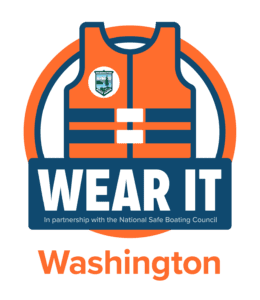
Be Prepared. When boating in open water such as lakes, rivers, ponds, Puget Sound, and the ocean — you can never be totally safe, but you can be better prepared.
Completing the mandatory boating education required to safely operate a recreational boat in open water can save your life and potentially those of others.
Open water is unpredictable, and conditions can change in a matter of seconds!
Some conditions to be aware of include:
Source: National Safety Council (NSC), Washington State Parks Boating Program
Whether you cruise, sail, kayak, fish, or do yoga on a stand-up paddleboard (SUP) — you are responsible to know the laws and basics of boating safety.
After successfully completing a boating safety course, the Washington State Parks and Recreation Commission requires the purchase of a $10 Boater Education Card. These may be purchased by submitting a Washington State Parks & Recreation Boating Commission Boater Education Card Application (including copy of your completed boating safety course certificate).
Your Boater Education Card will be mailed within 3-4 weeks. It is valid for your lifetime and meets requirements for recreational boating in Canada and many other states.
Source: BoatUS Foundation
To ensure the safety of yourself & others, get to know Washington state’s current boating laws
For more helpful information, checkout the Washington State Parks’ Adventures in Boating Washington Handbook including laws on:
Life Jackets SAVE LIVES – WEAR IT!

State law requires all vessels (including canoes, kayaks and stand up paddleboards) to carry at least (1) properly fitted U.S. Coast Guard-approved life jacket (also known as a personal flotation device or PFD) FOR EACH PERSON ABOARD A VESSEL.
Life jackets (PFDs) are one of the single most effective pieces of safety gear on a boat. Study after study show that if you wear your life jacket, you’re more likely to survive if something goes wrong.
Boating and paddling is often a fun activity, but it’s not without any risks. In Washington, many of our waterways are cold year-round. People that drown are often victims of cold-water shock. Anyone can drown regardless of age and swimming capabilities. Protect yourself by always wearing a life jacket.
Many people assume merely having life jackets onboard is sufficient. However, accidents happen rapidly and without warning. Usually, there is not enough time to grab a life jacket, so they should always be worn!
A life jacket only works if you WEAR IT.
KNOW THE LAWS >>
Boating & drinking alcohol ARE NOT not a good mix!
In 2021, alcohol was the #1 known contributing factor in fatal boating accidents, accounting for 86 deaths.
In Washington state, alcohol use is the leading contributing factor in 17% of boating fatalities in the state. There are penalties for operating a boat under the influence (BUI):
Learn more about Washington state boating laws & regulations >>
A boater who is involved in an accident MUST STOP!
A boater who is involved in an accident MUST STOP their vessel immediately at the scene of the accident and assist injured people or anyone in danger, unless doing so would endanger his or her own vessel or passengers. In some circumstances, the boater operating the vessel must submit a written accident report.
Accident report forms are available from Washington State Parks and Recreation Commission and local law enforcement marine units.
Washington State law requires the operator of a recreational vessel involved in an accident to file a Washington Boat Accident Report (PDF) when:
If there is an injury, disappearance or death, a report must be submitted within 48 hours. Reports in other accidents must be submitted within 10 days. If the operator cannot submit the report, the owner of the vessel is responsible.
Reports must be submitted to the law enforcement agency (PDF) that has jurisdiction where the accident occurred. If you are not sure what agency has the authority, contact the Washington State Boating Program by email or call (360) 902-8555.
The report is confidential and will only be used by government agencies for statistical purposes. Failure of an operator to submit a report can result in a fine.
Register your boat with the Washington State Department of Licensing
To navigate, operate, employ, or moor your vessel in the state of Washington, you must have a Washington title, registration card, and registration decals, except when your vessel is:
REMEMBER: Your registration card (the cutout portion of the Vessel Registration Certificate) must be onboard whenever you use your vessel.
Source: Washington State Legislature, Washington State Recreation and Conservation Office, State Law Dashboards – NASBLA, Washington State Parks Boating Program
Why should you take the time to make a Float Plan?
The answer is simple… there are just too many facts that need to be accurately remembered and ultimately conveyed in an emergency situation!
Without a Float Plan, you are counting on someone else, a friend, neighbor, or family member to remember detailed information that rescue personnel need to find you – important information that can make a difference in the outcome.
What type of boaters should make a Float Plan?
Typically, the Boat Operator is the individual who prepares the Float Plan. However, all persons onboard should be aware of the importance of letting someone know where you are going and when you will be back. Don’t be afraid to ask the operator if they have left a Float Plan with a reliable person.
It is also recommended that you include a recent photo of your vessel.
In 2021, where cause of death was known:
Washington state law (RCW 79A.60.160) requires children ages 12 years and younger to wear a Coast Guard approved life jacket or vest on vessels less than 19 feet long.
Download the U.S. Coast Guard’s guide on How to Choose the Right Life Jacket >>
Cold Water Immersion
Boating in cold weather can be exhilarating, but it also puts you at risk of falling into dangerously cold waters. Even boating in warm weather can be dangerous if the water is much colder than the air.
Cold water immersion is almost always the result of a capsize or swamping of, or falling overboard from, a boat under 26 feet. In each distinct phase, a person (without a life jacket) faces a MUCH HIGHER risk of drowning in cold water.
Phases include:
Once a victim’s shivering stops, their core body temperature begins to critically drop. Follow these steps to prevent a victim’s body from cooling:
REMEMBER TO NEVER:
Source: Washington State Legislature, King County, U.S. Coast Guard, BoatUS Foundation
How does this FREE statewide program work?
If you go out boating and don’t have a life jacket (PFD) – or find that yours doesn’t properly fit – you can use this NEW interactive map to locate a Life Jacket Loaner Station!
Participating marinas, boat ramps, paddle craft launch sites and Washington State Parks are now equipped with infant, child, youth and adult-size life jackets (PFDs) for recreational boaters to borrow—at no charge.
When finished, simply return the borrowed life jackets (PFDs) to the same station where they were borrowed.
Source: Washington State Parks Boating Program, Seattle Children’s
Interested in hosting a Life Jacket Loaner Station?
The Washington State Parks Boating Program, in partnership with the Washington Drowning Prevention Network, can help you to provide life jackets (PFDs) to the public through a FREE statewide Life Jacket Loaner Station program.
The goal of this program is to increase the use of life jackets (PFDs) and to educate recreational boaters about the importance of wearing a properly fitted life jacket. Each host will receive signage with fitting instructions (in English and Spanish) that should be prominently displayed at their Life Jacket Loaner Station.
Apply today >>
Source: Washington State Parks Boating Program, Seattle Children’s
Take this pledge in partnership with the Seattle Mariners
Recreational boating is a popular pastime in Washington state — just ask any of the several hundred thousand residents who own at least one canoe, kayak, rowboat, personal watercraft, stand up paddle board, drift boat, runabout, sailboat, motor yacht or some other type of recreational vessel. Boats and boaters are everywhere!
Boating, however, isn’t without its risks. The chilly waters of the Pacific Northwest can be an unforgiving environment, and safety must be on the minds of everyone who plays in and around it.
Take this pledge in partnership with the National Safe Boating Council
Real boaters always #WEARIT. Be an example and save lives!
Recreational boating and water activities are enjoyed by millions of Americans each year. Boating safety advocates recommend all boaters and passengers not only have a life jacket – but wear it at all times while boating!
Regardless of your age or experience level, LIFE JACKETS SAVE LIVES!
Life Jacket Coupon
U.S. Boating Law Administrator Directory
King County Area Public Lifeguarded Beaches
American Red Cross
Water Safety Resources for Parents, Children & Teens
Protect Your Natural Hair (while swimming)
Life Jacket Loaner Program
International Life Saving Federation’s Drowning Chain of Survival
NEW Open Water Swimming Safety Toolkit
Seattle Children’s and Washington State Drowning Prevention Network (WA DPN)
Drowning Prevention Toolkit
Interested in becoming a lifeguard?
SPLASHForward’s Water Safety Resources
#RecreateResponsibly
#PaddleWise
#WearingIt
Visit our Digital Resource Center to learn more about Boating Safety and Drowning Prevention — plus, more injury and violence prevention topics year-round!